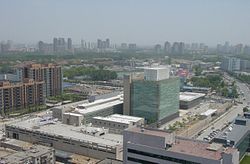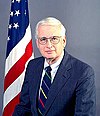The Embassy of the United States in Beijing is the diplomatic mission of the United States in China. It serves as the administrative office of the United States Ambassador to China. The embassy complex is in Chaoyang, Beijing.[1]
| Embassy of the United States, Beijing | |
|---|---|
  Embassy as seen from above | |
 | |
| Location | |
| Address | 55 Anjialou Road, Chaoyang, Beijing |
| Coordinates | 39°9′53″N 116°4′59″E |
| Ambassador | R. Nicholas Burns |
| Website | china |
In addition to Beijing, it covers the municipalities of Tianjin and Chongqing and the provinces of Gansu, Guizhou, Hebei, Henan, Hubei, Hunan, Inner Mongolia, Jiangxi, Ningxia, Qinghai, Shanxi, Shaanxi, Shandong, Sichuan, Tibet, Xinjiang, and Yunnan.[2]
History

The current U.S. Embassy in Beijing was opened and dedicated on August 8, 2008, by U.S. President George W. Bush[3] and is the third largest American diplomatic mission in the world, after the Embassy of the United States, Baghdad and the Embassy of the United States, Yerevan. The U.S. embassy had its origins in 1935 when the legation was upgraded into the embassy in Nanjing. However, the central government of the nationalists was relocated to Taipei in 1949 due to the Chinese Civil War and the embassy was reopened in 1953. On January 1, 1979, the embassy was transferred to Beijing after normalizing relations with the communist government on the mainland.[4]
The 500,000-square-foot (46,000 m2), eight story facility incorporates a great deal of free-standing transparent and opaque glass in its design. It is located on a 10-acre (4.0 ha) plot of land. The embassy warehouse is located in the Beijing Tianzhu Airport Industrial Zone in Shunyi District.[5]
Since the embassy is legally out of reach of the Government of China, it was used as the hiding place of Chinese dissident Chen Guangcheng after he escaped from house arrest.[6]
Principal officers
Ambassadors
Deputy Chiefs of Mission (DCM)
| Name | Portrait | Start of term | End of term |
|---|---|---|---|
| J. Stapleton Roy |  |
1979 | 1981[7][8] |
| Chas W. Freeman, Jr. |  |
1981 | 1984[9] |
| Herbert E. Horowitz |  |
1984 | 1986[10] |
| Peter Tomsen |  |
1986 | 1989[11] |
| Raymond Burghardt (acting) |
 |
1989 | 1989[12][13] |
| B. Lynn Pascoe |  |
1989[12] | 1992[a] |
| Scott S. Hallford | 1992[a] | 1996[16] | |
| William C. McCahill, Jr. | 1996 | 1999 | |
| G. Eugene Martin | 1999 | 2000[17] | |
| Michael W. Marine |  |
September 2000 | June 2004[18] |
| David S. Sedney |  |
2004 | 2007[19] |
| Dan Piccuta | May 2007[20] | January 2009 | |
| William Weinstein (Acting) |
January 2009[21] | July 2009[22]: 74 | |
| Robert Goldberg | July 2009[22]: 74 | 2011[22]: 5 | |
| Robert S. Wang |  |
January 2011 | August 2013[23] |
| Daniel Kritenbrink |  |
July 2013 | 2015[24] |
| David H. Rank | January 2016[25] | January 2017 | |
| Julie L. Kavanagh (Acting) |
January 2017[26][27] | June 2017[26] | |
| Jonathan Fritz (Acting) |
 |
June 2017[28] | 2018 |
| Robert W. Forden |  |
July 2018 | October 2020[29] |
| William Klein (Acting) |
 |
October 2020[30] | October 2021 |
| Bobby Richey (Acting) |
 |
October 2021[31] | |
See also
- List of diplomatic missions of the United States
- United States Ambassador to China
- U.S. Consulate General Chengdu
- U.S. Consulate General Guangzhou
- U.S. Consulate General Shanghai
- U.S. Consulate General Shenyang
- U.S. Consulate General Wuhan
- Consulate General of the United States, Hong Kong and Macau
- Embassy of People's Republic of China in Washington, D.C.
- International School of Beijing
- Americans in China
Notes
References
External links
Wikiwand in your browser!
Seamless Wikipedia browsing. On steroids.
Every time you click a link to Wikipedia, Wiktionary or Wikiquote in your browser's search results, it will show the modern Wikiwand interface.
Wikiwand extension is a five stars, simple, with minimum permission required to keep your browsing private, safe and transparent.
